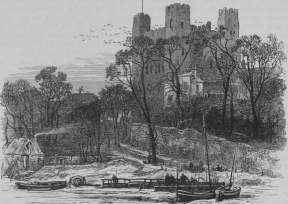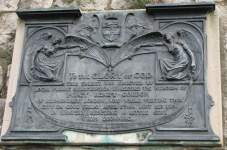 View of Rochester Castle.
View of Rochester Castle.
From London, British rail from Victoria or Charing Cross, about 1 hour, typically a couple of trains per hour.
Rochester, a town on the Medway, is included here because it is such a splendid day out and so convenient to get to from London, rather than because of the amount of Victorian art there. The real reasons to go are the castle, the cathedral, and the 'English village' feel to the place. Having said that, there are Victorian connections - the local history museum, which contains a restored Victorian interior, and Charles Dickens, who lived in the locality and used it as a background for many of his novels.
The area has strong associations with Dickens, and various of the buildings described in his books are in Rochester. Walking down the charming high street reveals several of these, typically 18th C and older, all kept in good repair, and discreetly labelled with the novels that they appeared in. A Charles Dickens Centre occupies a rather magnificent 16th Century building on the high street. This building, called Eastgate, is itself featured in The Pickwick Papers and Edwin Drood.
Also on the high street is the free museum, divided across two buildings. The first of these covers the period from prehistory through the building of the castle in Norman times right through until early Victorian times, naturally concentrating on the history of Rochester, especially the Castle and Medway interest. At the top of the building is the Guildhall Memorial Chamber, 1695-6, with ornate ceiling paid for by Cloudesley Shovell. In the room and outside on the stair, hang about a dozen full length large portraits, and a couple of smaller works. These date from the 18th and 19th Centuries, including 2 Royal ones attributed to Sir Godfrey Kneller, and others to Daniel de Coning. Among the latter are Richard Watts MP, 1563, local philanthropist (see further down page), and Shovell himself, early 18th Century - there is also a small oil portrait in a case, of him as a young man. Part II of the museum covers the Victorian period and after. The interior is done up in Victorian fashion, with pictures on the staircase, nice lamps dotted around, dark heavy carpets, and a claustrophobic feel. It is this overall effect rather than the quality of individual objects that is notable. Among the two dozen paintings, mostly of local interest and mostly unlabelled, are works by the local artist Spencelayh. Also in the museum is a room devoted to the 'Horton Collection' of Victorian toys, jewellery, fabrics and other knick-knackery, and a busy Victorian Parlour.
So much for the Museum. The impressive Cathedral, with its monuments, deserves a page of its own. Around the cathedral and between it and the high street are medieval and later buildings, so that there are two or three pleasingly old passageways to wander down.
In front of the Cathedral is a gnarled, collapsed and supported tree that looks at least as old as the cathedral. Alas, a small sign anxiously pleading with visitors not to vandalise it says merely that it is 'over a hundred years old' and is an uncommon Catalpa tree (American Indian Bean Tree).
The castle, besieged, defeated and refortified in the 13th C, is remarkable because of its completeness and large size. This is best appreciated by climbing up it - about four floors - and one can look straight down the gutted interior to the basement. Also good views. It seems to me one of the best castles - not a total ruin because Cromwell smashed it down, and not merely a countrified residence with a few fortifications. On the outer defensive wall by road below, is a small plaque commemorating Percy Henry Gordon, who died in 1912 rescuing a little girl from drowning. It shows a pair of angels in high relief, and is signed by W. C. Barker - there may be a double barrelled name, but it is defaced.
 Plaque to Gordon, by W. C. Barker.
Plaque to Gordon, by W. C. Barker.
Otherwise, Rochester is designed for the daytripper from London, with tea shops, bakeries and antique shops containing Victorian and reproduction objets d'art and furniture, a large second-hand bookshop and a small one, and various other amenities. Among the various Dickensian buildings are some other interesting ones - indeed, the whole High Street is virtually unsullied by incursions from the late 20th Century. In particular, next to the Visitor Centre is the Richard Watts Charity Building (his portrait is noted in the Museum above, and he has a monument in the Cathedral). Founded 1579, for
'6 poor travellers who being not rogues or proctors may receive gratis for 1 night lodging, entertainment and 4 pence each'.The charity was executed in 1836, and the building presumably dates from around then. Further down, and off to one side, the French Almshouses (La Providence) date from around 1840. We may also note, down another side street, the Edwardian Gothic Baptist Church, 1907, by C. E. Bond, who carried out other work in Rochester, next door to the older (1890) and more modest Baptist Centre.
There are good walks along the water in summer. A large 19th C iron bridge (redone 1914) goes across the water to Strood, which is downmarket and less interesting to the casual visitor, but from half-way along the bridge there is an excellent view back towards the castle. Two bronze lions guard the approach, and there are also small bestial heads of more lions and bears .
Chatham is a gentle 25 minute walk from Rochester station.
Rochester Cathedral // Chatham // Sculpture pages // Statues in English towns
Visits to this page from 13 Mar 2014: 5,986